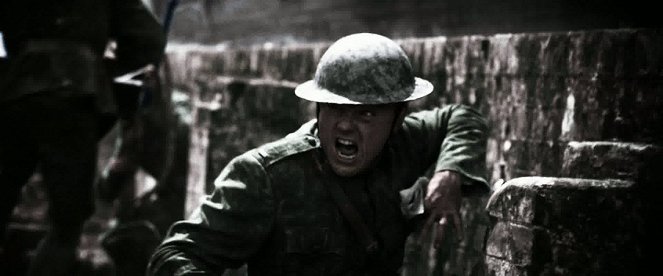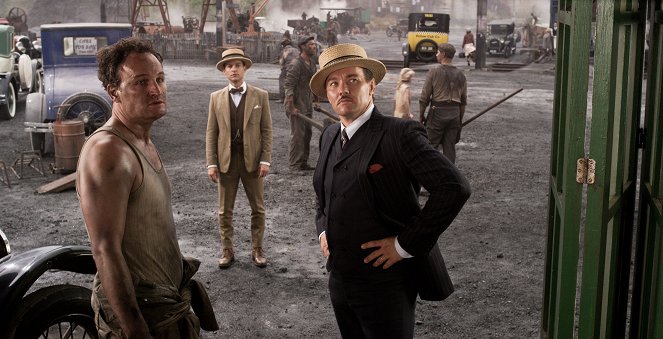Director:
Baz LuhrmannCámara:
Simon DugganMúsica:
Craig ArmstrongReparto:
Leonardo DiCaprio, Tobey Maguire, Carey Mulligan, Joel Edgerton, Isla Fisher, Jason Clarke, Elizabeth Debicki, Jack Thompson, Amitabh Bachchan, Gemma Ward (más)Streaming (4)
Sinopsis(1)
Cuenta la historia ideada por Fitzgerald de un aspirante a escritor, Nick Carraway, que deja el medio oeste y llega a Nueva York en la primavera de 1922, una época de relajamiento moral, deslumbrante jazz, reyes del contrabando y en la que la Bolsa sube como la espuma. Nick, que busca su propia versión del sueño americano, tiene como vecino a un misterioso millonario que da muchas fiestas, Jay Gatsby, y al otro lado de la bahía están su prima Daisy y el mujeriego marido de sangre azul de ésta, Tom Buchanan. Así es como Nick se verá inmerso en el mundo cautivador de los súper millonarios, sus ilusiones, amores y engaños. Nick, mientras asiste a sus vidas como testigo, dentro y fuera del mundo en el que habita, escribe una historia sobre un amor imposible y sobre sueños incorruptibles, y contempla una tragedia de alto octanaje, reflejo de nuestra época moderna y sus dificultades. (Warner Bros. España)
(más)Videos (28)
Reseñas (15)
Un triángulo amoroso teatralmente sobreexpuesto, con un aspecto visual animado, pero con un alma aburrido. Luhrmann usa lo que funcionó Moulin Rouge, pero a la profundidad de sentimiento de amor trágico ni siquiera se acerca. Al personaje de Gatsby vamos muy lentamente, con grandes expectativas, y Leo luce bien en los trajes pálidos (como todos los demás), pero, paradójicamente, el elemento más despersonalizado y controvertido de la película resulta ser su personaje. Pero su personaje ya nos da igual, siendo lo más importante de la película justamente la historia de él y como va detrás del sueño de su vida, que es la bella Daisy. Mulligan es solo un adorno, y Edgerton, como su duro esposo, resulta ser más significativo que Gatsby de Leo. El único personaje natural aquí es el «representante del pueblo» interpretado por Maguire. A Moulin Rouge le daban la vida las canciones originales enérgicas o emocionalmente atractivas. El Gran Gatsby saca a relucir los hits cien veces escuchados de Jay-Zi (identificación con Nueva York) y el cautivador hit de Lana Del Rey intenta en vano añadir una dimensión romántica al libro de acordeón de imágenes opulentas. Un tema tan fuerte, tantas ideas grandes... Y los ojos de los espectadores permanecen secos. ___ Vi la película por segunda vez: La escena de la confrontación de los personajes en la habitación del hotel, es que si toda la película se hubiera hecho como esta escena, es decir, de cámara, y de manera psicológicamente concentrada y dramatúrgicamente sensible, es decir, sin excesos formales innecesarios; y la música hubiera ayudado solo en escenas clave con Lana Del Rey, podría haber sido una película *excepcional*.
()
Two and a half stars for the soundtrack, which is not even properly used. The film itself didn’t do for me, but I will give it another chance after some time. The first time I watched it, it irritated me in a similar way as the beginning of Moulin Rouge! … But whereas Moulin Rouge got better as the story progressed, Gatsby irritated me throughout. Maybe next time.
()
The make-up and lighting make Gatsby look like a leaked Madame Tussaud model. Luhrmann's lust for the most effective imagery neuters the sketches of everyone else, making The Great Gatsby the most poorly narrated (and subjectively longest) blockbuster of the season; a good party ends without a hangover, but here you're dragged to the sidelines with a queasy stomach before its climax.
()
It starts as intoxicating kitsch, then it becomes a tiresome mess stumbling on both feet. As far as gimmicky camera tricks and image wizardry go, Luhrmann is confident, but he fails in simple meaningful storytelling and in trying to get under the skin of the characters. I've mentioned kitsch – all those lavish parties make you feel like you're looking at a big garden dwarf, festooned with colourful ribbons and flashing light bulbs. But when it comes to feelings, it's like a shallow story in a girlie magazine, kind of plucking the daisy "He likes you, he likes you not, he likes you, he likes you not, he'll leave with you, he won't leave with you.....". Thank goodness for at least two things: Edgerton's manly Buchanan, the only full-blooded character in the entire panopticon, and the reunion scene between Gatsby and Daisy – the only moment in the entire film where you can feel any emotion. Luhrmann is getting a little stale.
()
The more problematic the film, the more you expect a standard adaptation of a classic book. The world of New York high society simultaneously disgusts and attracts Nick. He is aware of his ambivalent position as a person both on the inside and on the outside, a person who simultaneously wants and doesn’t want to be part of the story being told, and he is not only able to reflect that position, but he has to reflect it in his own interest. The narrator’s deeply personal relationship to “his” story and to the characters is emphasised by the fact that for Nick, retrospectively reconstructing who Gatsby actually was is a form of psychotherapy (similarly to the way that the search for the meaning of the word “rosebud” was an attempt to find the truth in Citizen Kane). Given the obvious hints that Nick is Fitzgerald’s alter-ego, writing (or rather retelling) as a form of therapy becomes one of the key motifs of the film. Also, the storyline involving the relationship between Nick and Gatsby (which strikingly lends itself to a queer reading) is ultimately the most authentic aspect of the film and, together with the therapeutic level of the narrative, rationalises the film’s double ending. ___ Like the narrator, Luhrmann sympathises with the characters, yet he places them in the surreal Technicolor world of major studio films, thus turning them into mere abstract ideas. In this rendering, Gatsby is merely the essence of the American mentality (the tenacious, self-destructive effort to achieve a particular ideal) and DiCaprio plays him accordingly. ___ Highlighting the narrative framework in comparison with the book (in which Nick simply tells the story, and why and to whom he is telling it are not important) is not a gratuitous attempt to bring a bit of tabloid subtext into the story – it rhythmises the narrative (“stepping out” of the story occurs at regular intervals) and influences its style. At the beginning, Nick speaks rapidly, as he is fascinated by all of the new stimuli and feels the need to quickly express all of his impressions. The cuts are abrupt and unexpected, and the shots are so short that it is difficult to find one’s bearings in them (it almost seems that there is a separate shot for every sentence). The camera never stops moving and, more so than later in the film, Luhrmann uses lap dissolves to create the impression that one shot blends into the next. The images sparkle, dazzling us with intense colours and CGI effects. We later become aware of the significance of the Sirk-like excessive work with colours, when it becomes clear why Myrtle was characterised in red and Gatsby in blue, or why it is important to know what colour Gatsby’s car is. The soundtrack is just as boisterous as the visual component of the narrative. ___ The choice of songs is the most striking (or rather loudest) link between today and the period in which the narrative is set. The soundtrack’s producers succeeded in selecting songs that can be imagined as contemporary alternatives to the music that was popular in the Roaring Twenties, though there is again a certain exaggeration (the shot of a car full of black people is accompanied by gritty gangsta rap). With its genre diversity, the soundtrack serves as an effective way to map the changes in mood that the film undergoes. ___ The film settles into a calmer, more classic style only after Nick’s story stabilises and focuses on Jay Gatsby as a man who personifies the limits of the American desire for success. The shots are longer, the narrator’s vocabulary is more colourful (which is also connected to the fact that Nick starts typing instead of speaking) and the lighting of the scenes is more natural. Together with the slowing of the film’s pace, the primary sources of inspiration also change. Whereas the noisy and flamboyant first third takes inspiration from the musicals of Busby Berkeley (and, I would venture to say, from the extravagant French epic productions of Marcel L’Herbier and other poetic realists), the film gradually progresses through excursions into gangster, adventure and war movie to a combination of social drama (The Crowd) and melodrama. Due to the doubling of the romantic storyline, however, it is rather an ironic commentary on the genre of melodrama (a sign that Luhrmann was not entirely serious is the pool shot in the film’s climax, which makes reference to the opening minutes of one of Hollywood’s most biting satires). ___ Because of the lifeless characters and excessive care taken to ensure that viewers understand exactly what is happening in the story, The Great Gatsby is an emotionally apathetic and laughably simple film. However, it is not a nonconceptual patchwork for lovers of pretty, shiny objects and expensive champagne (of one particular brand), though it does at first deceptively seem to be just that, even more so than Luhrmann’s earlier attempts to make the past present. 80%
()
(menos)
(más)



Anuncio